Historical Commission Weighs in on Large Requests for CPA Funds for Jones Library and Town Hall Roof
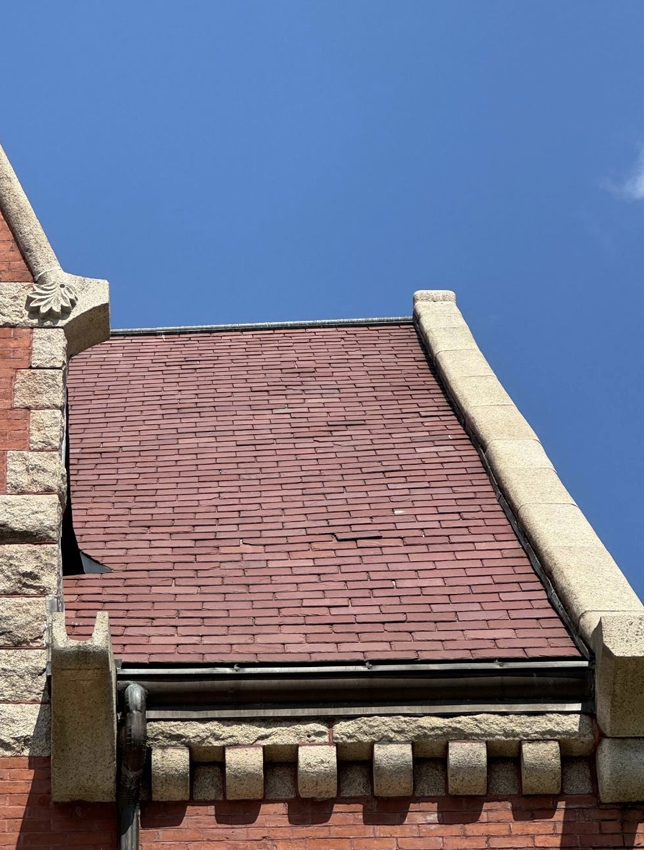
The red slate root at Town Hall, installed in 1893 needs to be replaced. The estimated cost is $2 million. Photo: amherstma.gov
Meeting of the Historical Commission, October 20, 2025
By Hilda Greenbaum
This meeting was held over Zoom and was recorded.
Present
Robin Fordham (chair), Pat Auth, George Baitinger, Kenzie Landesittel, Joel Greenbaum, and Hetty Startup. Staff: Walker Powell (Planner)
The Historical Commission discussed and prioritized the eight proposals for Community Preservation Act (CPA) funds for historical preservation submitted to the Community Preservation Act Committee for FY 2027, and will forward its recommendations to the committee. The total request for historical preservation funds is $3.9 million. CPA funds come from a 3% property tax levy that is matched by state funds. The funds are to be used for affordable housing, historical preservation, and open space and recreation. In a typical year, Amherst has about $2 million available to fund eligible projects. A minimum of 10% of the total must go to each of the three areas.
The largest requests this year were $1.3 million from the Jones Library for historic millwork preservation and replacement windows in the 1928 portion of the building as part of the ongoing expansion project, and $1 million from the town to replace the badly degraded red slate roof on the 1893 Town Hall (reduced from the $1.8 million in the application). The Jones Library project previously received $1 million in CPA funds for Special Collections in FY21 that will also be used in the renovation/expansion project..
Each applicant gave a presentation about their project. However, Bryan Harvey, who was to represent the Mill River historical survey and signage, did not receive his notification, so he will come to the November 17 Historical Commission meeting to speak about that project.
Historical Commission Recommends Reduction in Jones Library Request
The Jones Library presentation was introduced by Capital Campaign co-chair Kent Faerber. He was accompanied by Capital Projects Manager Bob Peirent, Facilities Director George Hicks Richards, and several members of the architect firm of Finegold Alexander Associates. Historical Commission chair Robin Fordham recused herself from the presentation and discussion, because of her association with the Massachusetts Historical Commission, with which the Jones Library has entered into a historic preservation agreement.
Faerber noted that the Jones Library is one of the most used buildings in town and its historic preservation is “front and center for the public,” since a couple hundred thousand people go through the building every year. CPA funds are being requested for preservation of the Philippine mahogany millwork, which will be removed, restored and replaced, notably in the front foyer and the director’s office. The Philippine walnut main stairway will be refinished, and some of the original oak floors will be restored. Funds were also requested to replace the windows on the 1928 building with insulated glass and new custom woodwork to match the original windows. The application also asks for funds to restore and repaint the woodwork around the door at the main entrance.
Architect Jim Alexander of FAA stated the CPA funds would help preserve the interior elements that were specified in the Memorandum of Agreement with the Massachusetts Historical Commission (MHC), since the restoration requires extra care. However, Peirent said that the $100,000 slated for removal of the woodwork in the grant proposal should be removed, because the removal has already occurred, and the FY27 CPA money is for work to occur after July 2026. Peirent said that funds were not requested for replacement of the slate roof, because that work is expected to be completed before July.
The funding for the $46 million project comes from the Massachusetts Board of Library Commissioners (MBLC) ($15.6 million), the Town of Amherst ($15.8 million), and the Jones Library Trustees, who must raise $13.8 million. Faerber noted that the project has received donations from 550 town residents, but lost a $1 million National Endowment for the Humanities grant due to cuts by the Trump administration.
In the discussion, Commission member Hetty Startup said she thought the windows and the millwork preservation were included in the existing budget for the project and should not be eligible for additional funding. Planner Walker Powell said it was not clear that the replacement windows would qualify for CPA funds.
Commissioners supported the use of CPA funds to preserve the historic woodwork on the interior and at the front entrance because they are important features of the library, but they did not recommend funding the window replacement, bringing the request down to $477,306. They also recommended funding the $75,000 estimated cost for moving the Civil War tablets from the Bangs Center to a dedicated room in the lower level of the new addition to the library. Because Fordham is the commission’s representative to the CPA committee and cannot participate in discussion of the Jones requests, Powell will write a narrative of the commission’s discussion and recommendation for the CPA committee discussion.
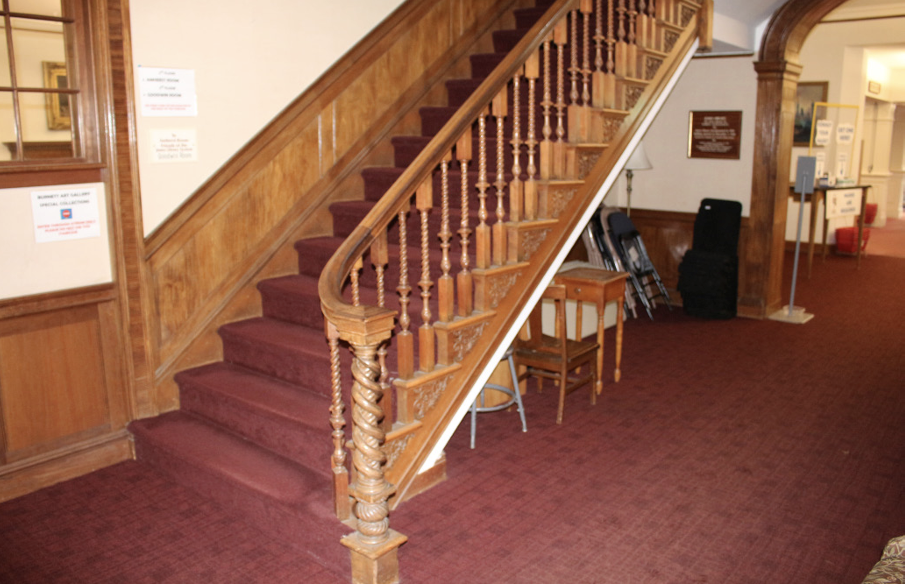
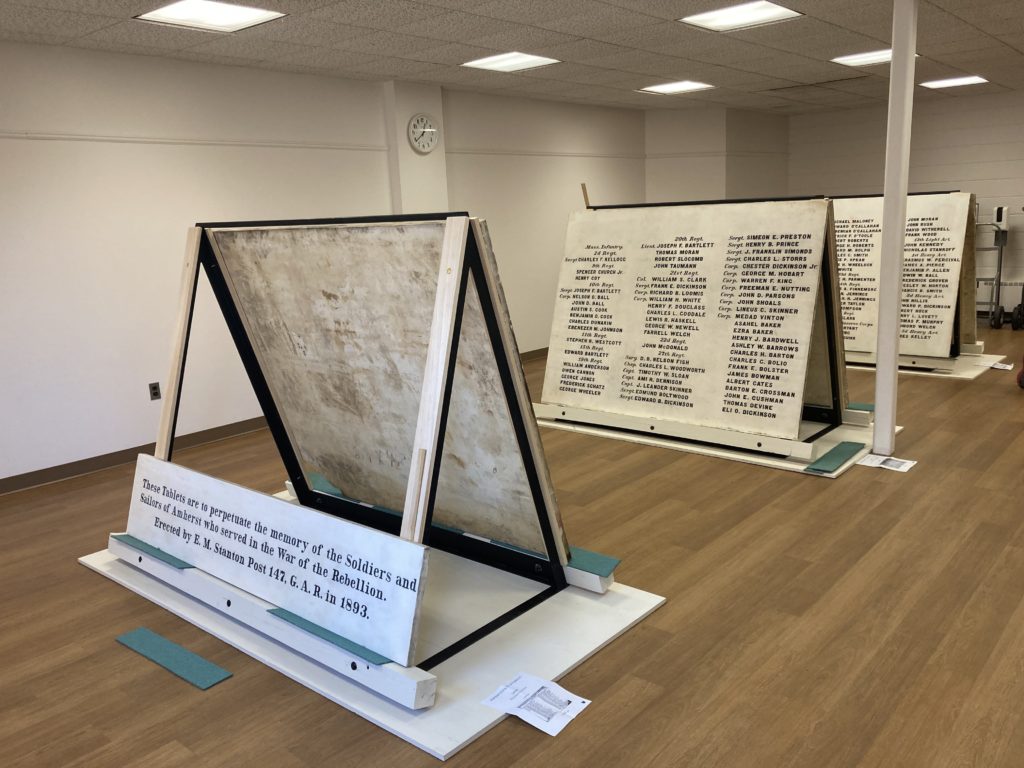
High Priority Funding for Town Hall Roof and Goodwin Church
The town requested $1 million, half the cost for the slate roof restoration on Town Hall. Jeremiah Laplante, Town Facilities and Maintenance Manager described (see photos) the toll that age and decay have taken on the original 1893 red slate roof. Deterioration of its underlayment is causing water damage to the attic timbers below. And, like the Jones Library, it was built with the finest materials and craftsmanship of the time. The original amount requested was $1.8 million, but the town plans to use capital funds for the balance of the repairs.
The commission agreed that this is a high priority project because water damage to the roof compromises the structural integrity of the historic town hall. “Cracking masonry, water intrusion, and poor insulation compromise both the building’s integrity and its energy efficiency.” Laplante said. The mastic (polymer/asphalt) repairs, the underlayment, and the copper flashing are failing, and the snow retention system is not distributing the load evenly, so a comprehensive roofing project is a high priority. Laplante showed where previous repair attempts have failed due to use of the wrong/cheaper materials and plans are to do the job correctly so that it will last another 100 years, the life of a slate roof. Red slate is only found at one location on the New York-Vermont border and thus is considerably more expensive than gray slate. Laplante has talked to several slaters who are able to do the job, so this profession is still alive and active.
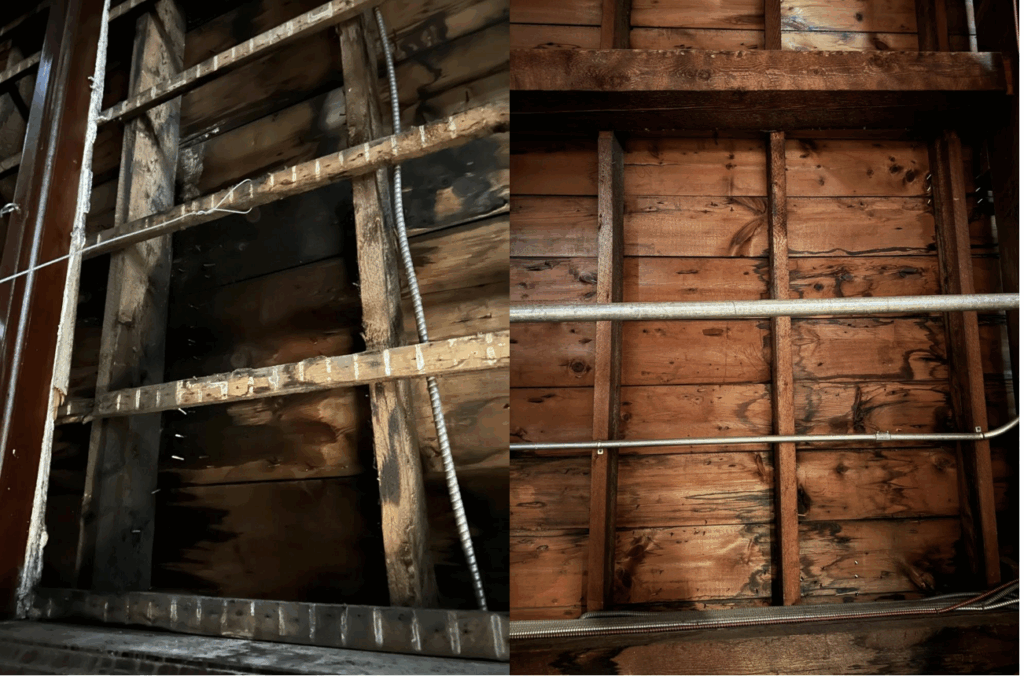
The project includes a full tear-off of the existing roof, salvaging at least 50% of the original 10 inch x 12 inch red slate tiles, repairing or replacing the existing roof deck, installing a weather-tight membrane underlayment, reinstalling the retained tiles and supplementing them with new slate tiles, and installing snow retention equipment. The west side facing the Town Common will be phase one of the project followed by the east side in phase two.
When Commissioner Joel Greenbaum asked him to break down the budget, Laplante responded that the total amount is over $2 million. The CPA funds will be supplemented by Joint Capital Planning Committee (JCPC) funds and the capital budget. Pat Auth asked at what point is this a town or a CPA responsibility, alluding to the repair of the front stone steps last year that was funded with a FY22 CPA allotment. Fordham stated, “CPA money is town money.” However, Auth worried about taking CPA funds from projects that have no other source of funding. Laplante stated that his entire JCPC budget for maintenance of all town buildings is a million dollars, so CPA funding was needed. The Commission recommended the project highly, noting that a project of this magnitude can be bonded over several years.
The historic Goodwin Church at 41 Woodside Avenue requested $48,000 for chimney and masonry repair. UMass Amherst Professor Emeritus of History John Higginson represented the application. He noted that the church is “a living testament of resilience and part of the historical journey of African Americans…a landmark of Black history.” The small but active congregation is asking for funds to repair and restore the basement and chimney because water seepage through the cracks is eroding the masonry as well as leading to mold and spores that threaten the health of the aging congregation.
In discussion, George Baitinger and Startup cited the lack of specificity in the proposal. Higginson mentioned roof repairs, but the application only specifies the chimney and cellar. The roof will be a separate project. The commission recommended that this modest project be funded because of the imminent risk of further damage from water leakage. Auth recommended that the application be more specific when it is presented to the CPA committee.
Questions Raised About Foundation Work for the Simeon Strong House
The Amherst Historical Society applied for $275,148 to stabilize and preserve the 250-year-old Simeon Strong House. Prior to the start of the Jones Library construction, the Historical Society found that the unexcavated northeast corner and wall (see photo) of the historic house required urgent repairs. The building has been closed to the public due to this discovery, with the Historical Society operating out of the former Knights of Columbus building on Boltwood Walk. The entire project to update the building and make it accessible is estimated to cost $2,700,000. Repairing the north wall foundation is phase one.
When Auth noted that there were no competing bids, she was told that Teagno Construction had been working with Jake Smith, the engineer, over the last two years in preparation for the larger project of heating and air conditioning, plumbing. and accessibility planned for the future.
This work will also include regrading the site so water will flow away from the house.
The application states that the heavy rains of the past two summers have eroded and undermined the stone pillars supporting the crawl space under the rear of the house, causing it to lean as well as causing cracks in the plaster.
Greenbaum thought that $275,000 was high for the repairs described and that the whole foundation could be repaired for that amount. Startup worried about more damage to the foundation from construction at the Jones Library next door. Although they supported the project and appreciated the urgency of completing the work, commissioners decided to request more information on the cost before recommending it to the CPA committee.
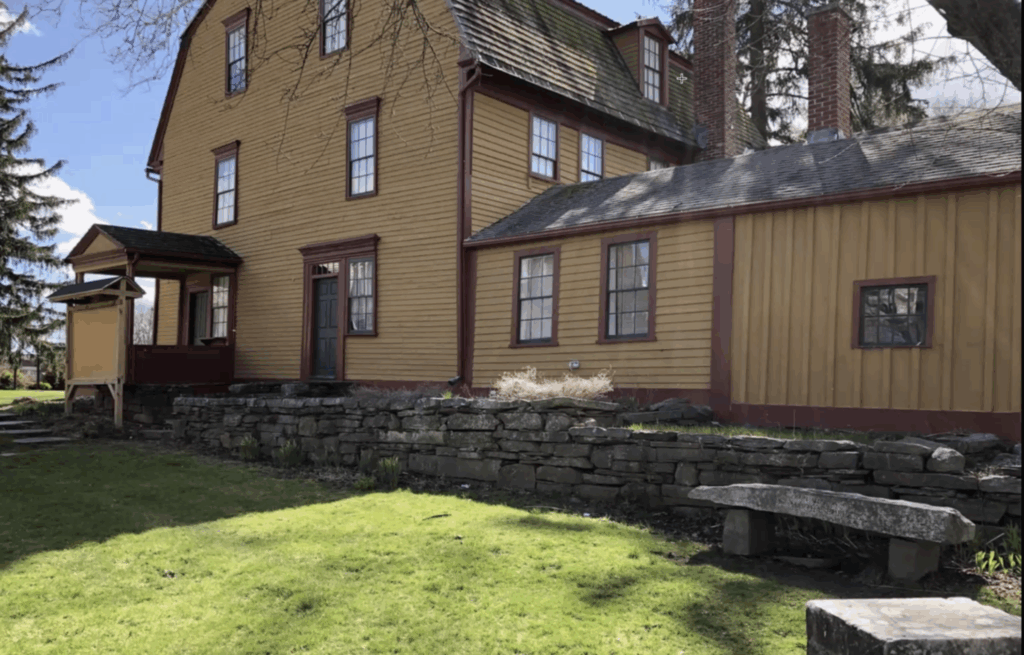
North and South Cemetery Headstones and Mill River Projects
The commission deemed that delaying the completion of the headstone restoration at the North and South cemeteries would not cause any adverse effects, so they rated the project a medium priority for funding of the $100,000 request. Restoration of the headstones at the West cemetery has already been completed.
No one was present to advocate for $105,000 for the completion of the historical survey for The Industrial History of the Mill River that was begun with CPA funding in FY24 and FY25. The survey focuses on” industrial development and subsequent abandonment from 1727 to the early 1930s.” A second proposal for $85,000 is to develop materials such as a website, signage, and markers along the Mill River trail, as well as printed materials. The scope of the original grant was based on four sites, but more than 35 mill and factory sites have been found.
The commission felt that the signage was not eligible for CPA funding. They could not make a decision on the survey and were unsure if CPA funds could be used for archaeology. Because of the lack of clarity about the proposal, no decision could be made. Representative for the project Bryan Harvey later agreed to come to the November 17 meeting.
Demolition Allowed for Farmhouse on Northampton Road
For the second time in three years the Historical Commission ruled unanimously that the modest late-nineteenth-century vernacular farmhouse at 406 Northampton Road, the last surviving farmhouse in what was 60 years ago an agricultural area, was historically significant but not “preferably preserved”, so no demolition delay was warranted. The house is in poor condition but important historically in that its owners were farmers and laborers. Auth noted that its context, the farms and fields, are lost but the history, architecture, and photos of the house should be recorded in the Massachusetts Cultural Resource Information Systems (MACRIS) before demolition takes place.
The owner of Zbylut Motors had an agreement with the Five-College credit union to build on that site, but the tenant refused to vacate, and the contract with the credit union lapsed. The tenant sued, and the case was settled in court last summer. There are currently no plans for the site in this Limited Business (BL) zone.
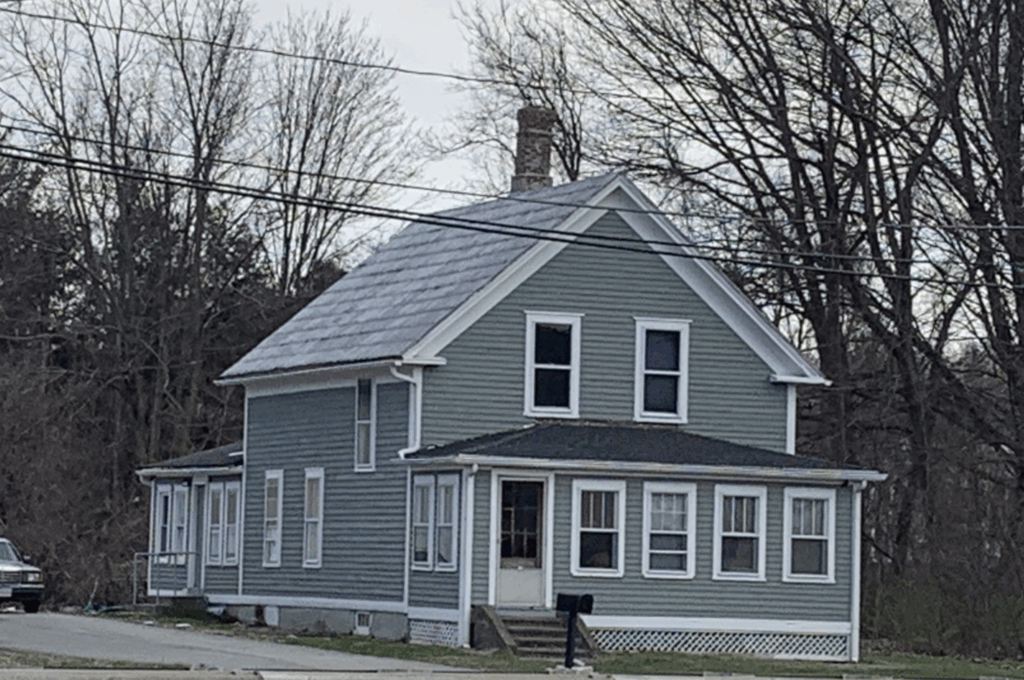
Preliminary Report on Inventory of Mid-century Modern Houses
Consultant Shannon Walsh reported on the status of the CPA-funded ($15,000) project to inventory the mid-twentieth century modern houses in Amherst. Among the many properties she cited Red Gate Lane and Maplewood areas, as well as the subdivisions of starter homes at Harlow Drive (historic “Jonesville”) and Orchard Valley. The one house she noted particularly that should be in the MACRIS inventory is 300 Flat Hills Road. She suggested that a subcommittee be formed to prune the list.
